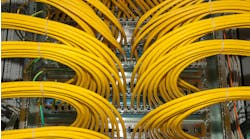Part working factory. Part showroom. All smart.
Late last year, metal-fabricating giant Trumpf opened the doors of a new type of facility—the Trumpf Smart Factory. Part working factory. Part showroom. Part tour destination. All digital transformation, demonstrating how a fully networked production system works in the real world.
The $30 million facility demonstrates fully transparent digital networking, offering customers the ability to continuously monitor the status of their projects. Indirect procedures are automated. Processes become more controllable, a particular advantage for small lot sizes.
While the facility, located in suburban Chicago, can serve global sheet-metal processors of all sizes, the target group is small/medium-sized contract manufacturers in the early stages of digital networking. Meanwhile, opportunities for the facility to educate tour groups about next-generation manufacturing are endless.
We chatted with Tobias Reuther, director of the Trumpf Smart Factory, to learn more. Take a look…
Smart Industry: What’s your mission here?
Tobias: This is a factory, not just a showroom. We’re using the latest technology in the manufacturing environment. We have real parts flowing through the facility and we’re bringing customers closer to the entire process, from order-entry to routing to cutting and bending, then onto shipping and invoicing. We’re looking ahead with our strategic decisions. We don’t care about economic cycles; we’re looking at long-term projects that are sustainable.
Smart Industry: Why is the customers’ role so important to the process?
Tobias: In showing this process we’re better able to learn from it. We’re getting feedback from our customers at every stage of the process. This is a collaborative space. And as we add more machines we can consult more customers on more processes, from greenfield efforts to remodeling shops.
Smart Industry: Who does this facility serve?
Tobias: Customers at job shops. Medical industries. Appliance makers. Cabinetmakers. Electrical shops. The aerospace industry. Sheet metal is pretty much everywhere. From job shops to OEMs with in-house sheet metal fabrication—John Deere, Ad Co., Caterpillar, Kubota, Siemens, GE, etc.
This facility is not just for North America. It’s our worldwide headquarters for Industry 4.0. We recently hosted a delegation from England; they were planning a new facility and wanted advice on laying out their floor and purchasing machines. We did a full consultation with them.
Smart Industry: Define a phrase you use about this facility—a “fully networked production system.”
Tobias: That means that, sitting in the control room, I can get every piece of information about every machine. I can see every routing order. I can get all of the information I need to control the shop floor. The view from production management differs from that of a programmer, who can get customized views. Fully networked means full transparently for everyone in the company. We can then choose what the customer sees.
Smart Industry: You tout the advanced ability to customize here. What advantage does this create for small lot sizes?
Tobias: That need came from industry. Single-piece flow is always the ultimate goal, and if you don’t have the technology to accommodate that you’re killing your costs. You’re killing setup time. Automation in hand with the control set is key to handling small batch sizes. This is only possible if the facility is fully automated and fully transparent. And this is driven by industry—the need for one-off orders as opposed to thousands.
Smart Industry: Describe the software in use at Smart Factory? What does this software enable you to do smarter?
Tobias: TruTops Fab is the software that enables our digitally connected production process. It gives the plant managers an overview of all the production jobs. They see all the orders, see if the machines are running correctly, if any are broken or sitting idle, and also reminds them of any planned maintenance that needs to be done. They can also control the machines with this software and manage inventory, which is what ultimately creates a fully-transparent and digitally connected manufacturing process.



